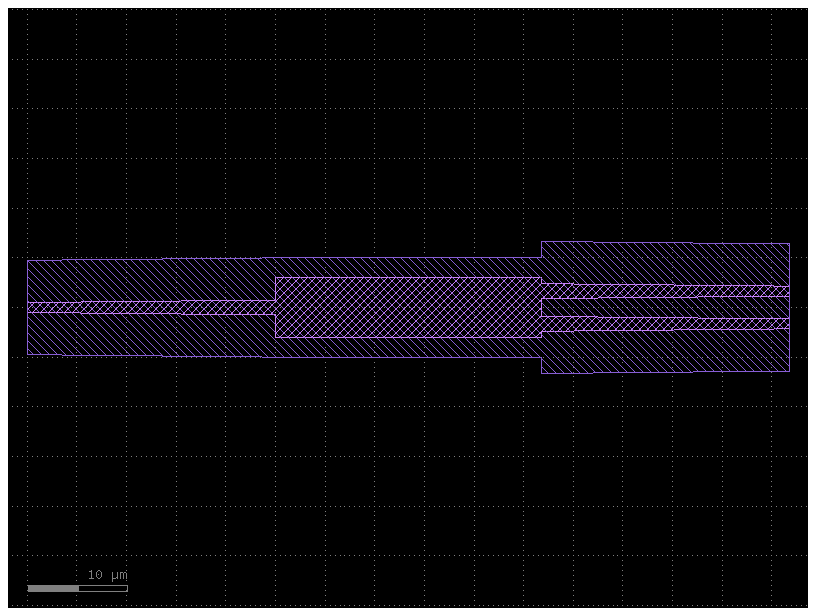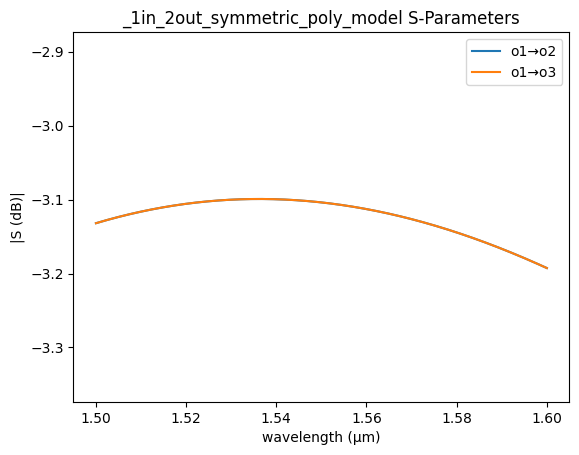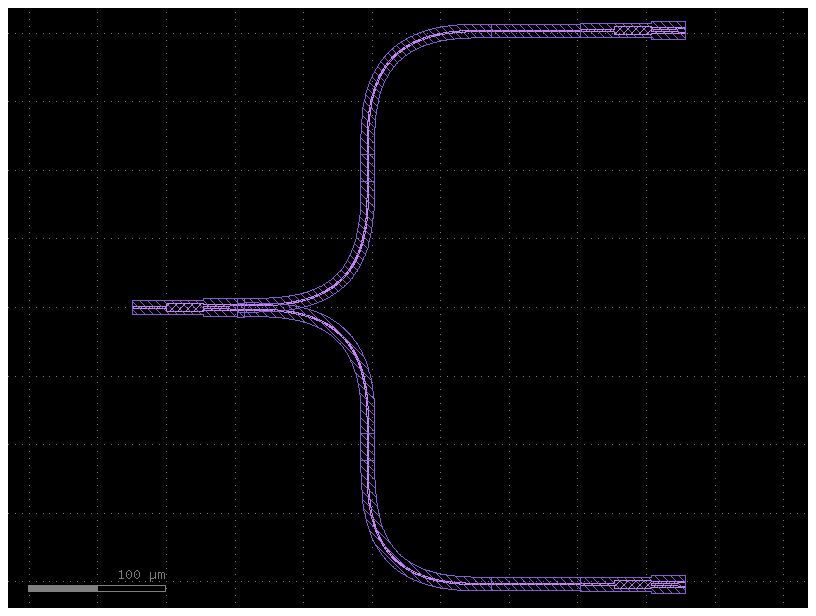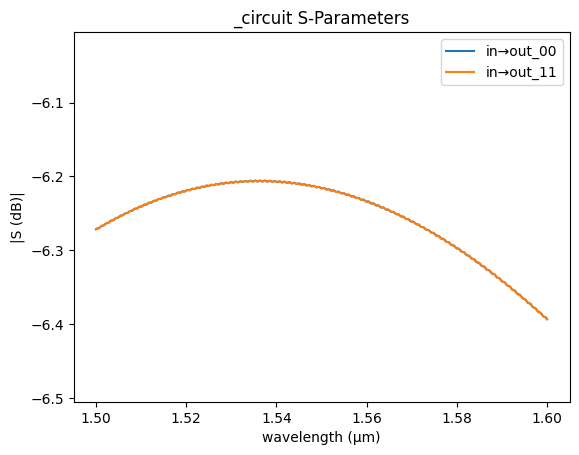Circuit models#
We provide circuit models for the PDK elements, implemented using the sax circuit simulator. A dictionary with the available models can be obtained by running:
models = lnoi400.get_models()
These models are useful for constructing the scattering matrix of a building block, or of a hierarchical circuit. They are obtained by experimental characterization of the building blocks and with FDTD simulations, that provide the full wavelength-dependent behaviour. Since the lnoi400 PDK is conceived for optical C-band operation, the model results should not be trusted below 1500 or above 1600 nm.
Examples of circuit simulation using sax#
import numpy as np
from functools import partial
import matplotlib.pyplot as plt
import gdsfactory as gf
import sax
import gplugins.sax as gs
import lnoi400
Circuit simulation of a splitter tree#
First, we display the circuit model of the 1x2 MMI shipped with the PDK.
splitter = gf.get_component("mmi1x2_optimized1550")
splitter.plot()

pcell_models = lnoi400.get_models()
mmi_model = pcell_models["mmi1x2_optimized1550"]
_ = gs.plot_model(
mmi_model,
wavelength_start=1.5,
wavelength_stop=1.6,
port1="o1",
ports2=("o2", "o3"),
)

We then build a simple, two-level-deep splitter tree, creating a new gdsfactory hierarchical component.
@gf.cell
def splitter_chain(
splitter = gf.get_component("mmi1x2_optimized1550"),
column_offset = (250.0, 200.0),
routing_reff = 90.0
) -> gf.Component:
c = gf.Component()
s0 = c << splitter
s01 = c << splitter
s02 = c << splitter
s01.dmove(
s01.ports["o1"].dcenter,
s0.ports["o2"].dcenter + np.array(column_offset)
)
s02.dmove(
s02.ports["o1"].dcenter,
s0.ports["o3"].dcenter + np.array([column_offset[0], - column_offset[1]])
)
# Bend spec
routing_bend = gf.get_component('L_turn_bend', radius=routing_reff)
# Routing between splitters
for ports_to_route in [
(s0.ports["o2"], s01.ports["o1"]),
(s0.ports["o3"], s02.ports["o1"]),
]:
gf.routing.route_single(
c,
ports_to_route[0],
ports_to_route[1],
start_straight_length=5.0,
end_straight_length=5.0,
cross_section="xs_rwg1000",
bend=routing_bend,
straight="straight_rwg1000",
)
# Expose the I/O ports
c.add_port(name="in", port=s0.ports["o1"])
c.add_port(name="out_00", port=s01.ports["o2"])
c.add_port(name="out_01", port=s01.ports["o3"])
c.add_port(name="out_10", port=s02.ports["o2"])
c.add_port(name="out_11", port=s02.ports["o3"])
return c
chain = splitter_chain()
chain

Let’s compile the circuit simulation using sax.
nl = chain.get_netlist()
models = {
# The Euler bend should be sufficiently low-loss to be approximated with a straight waveguide
# (if the frequency is not too low)
"L_turn_bend": pcell_models["straight_rwg1000"],
"straight_rwg1000": pcell_models["straight_rwg1000"],
"mmi1x2_optimized1550": pcell_models["mmi1x2_optimized1550"],
}
circuit, _ = sax.circuit(netlist=nl, models=models)
_ = gs.plot_model(
circuit,
wavelength_start=1.5,
wavelength_stop=1.6,
port1="in",
ports2=("out_00", "out_11"),
)

Simulation of a Mach-Zehnder interferometer with a thermo-optical phase shifter#
First we take a look at the cell layout.
mzm_specs = dict(
modulation_length=1500.0,
with_heater=True,
bias_tuning_section_length=1000.0,
)
mzm = gf.get_component(
"mzm_unbalanced",
**mzm_specs,
)
mzm.plot()

Then, we retrieve the circuit model and evaluate it for different wavelengths and voltages.
mzm_specs = dict(
modulation_length=1500.0,
heater_length=1000.0,
)
mzm_model = partial(
pcell_models["mzm_unbalanced"],
**mzm_specs,
)
fig = plt.figure(figsize=(7.5, 5))
wls = [1.4, 1.5, 1.6]
V_scan = np.linspace(-3, 3, 99)
for wl in wls:
P_out = [np.abs(mzm_model(
wl=wl,
V_ht=V,
)["o2", "o1"])
for V in V_scan]
plt.semilogy(V_scan, P_out, label=f'{wl} um')
plt.legend(loc='best')
plt.xlabel("Voltage (V)")
_ = plt.ylabel("MZM transmission")

